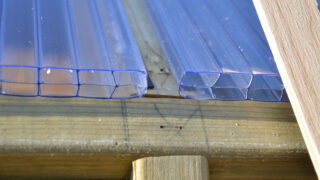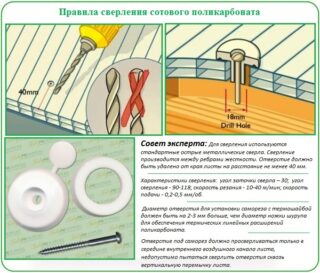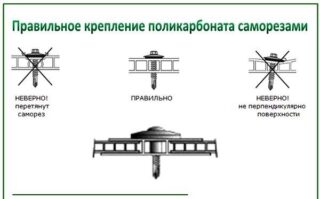The service life of polycarbonate sheds and greenhouses depends on the quality of building materials and the correct work. The installation of such structures is endowed with features, without which high quality cannot be achieved. This fully applies to the choice of polycarbonate fasteners to wood.
The nuances of fixing polycarbonate to wood

The reliability and service life of polycarbonate products is influenced by the selection and processing of materials, as well as correct installation. Before starting work, it is recommended to prepare special equipment and select a suitable fastening system. In this case, the structure will be durable and will last for many years.
If a metal frame is used for products with polymer panels, fasteners are chosen designed for these purposes. Similar conditions are imposed on the plastic base. Traditionally, however, the polycarbonate material is mounted on a timber frame. In this case, it is necessary to adhere to the rules and algorithm of work. Preparation for the installation of the structure begins with the choice of fasteners.
Choice of fastening system
Various methods are used to secure the polycarbonate sheet to the timber frame structure. Variants of self-tapping screws for fixing panels to wood:
- galvanized roofing with hex head and EPDM washer;
- with rubber thermal washer;
- with a polymer thermal washer;
- connecting profile.
The latter option is supplied in the form of a detachable and one-piece product for clamping cellular polycarbonate. The profile is attached to the frame with special clamps.
The presented systems are based on the use of self-tapping screws. A metal product provides fixation of two or more sheets due to a screw connection. The thread of the required length is created at the moment of screwing in. The full name of the fastener is a self-tapping screw.
Preparatory work
Before cutting the sheets, a strip of tape must be applied to prevent scratching. Before installing monolithic polycarbonate, the support surface of the lathing is adjusted for a snug fit of the sheets around the perimeter. If you ignore these works, the design will skew.
Laying of honeycomb sheets is carried out in such a way that 1-2 battens of the crate pass in the center of the canvas. Self-tapping screws with a pitch of 30 cm are exposed on the frame. Products with molded plastic are mounted using window technology.
If polymer panels are planned to be mounted on a slatted metal profile, it is necessary to equip the edge filing at the top and bottom. The collapsible profile is laid over the frame. After installation, part of the sheet is above the surface, hanging slightly, forming a visor. To protect against atmospheric precipitation, the bottom edge is overlapped with a wooden lath.
Fixing technology of polycarbonate to a wooden frame
Do-it-yourself installation of polycarbonate to a wooden crate is the most problematic work. This is due to the fact that buildings made of lumber lined with polymer panels are gaining moisture. Shrinkage and slight warpage of the structure negatively affects the geometry. Therefore, the installation instructions must be strictly followed.
Fixing cellular polycarbonate
Then the backing tape is laid along the marking line. The joint between the tree and the polycarbonate sheet is recommended to be sealed with good silicone. Joint treatment prevents condensation and fogging.
The process of fixing the sheets to the frame is simple, if you adhere to the algorithm:
- drilling holes for self-tapping screws;
- installation inside a silicone sleeve;
- fixing the washer on a self-tapping screw;
- screwing in self-tapping screws with a screwdriver.
Upon completion of the work, the end tape is installed and the protective film is removed from the surface. Gaps and joints are allowed to be covered with overlays.
Fixation of monolithic polycarbonate
The sheets are pulled together at the edges with self-tapping screws through the strips on which the seal is installed.
The fundamental difference between this method and the previous version of fastening is that the clamping force is distributed evenly over the entire web. This approach contributes to the reliable fixation of the sheets, regardless of the position of the structure.
If you try to fix a curved roof using a clamping bar, there is a risk of cracks in the material. The reason for this is the uneven load on the timber frame. Self-tapping screws will simultaneously hold the sheet and destroy it.
Silicone can be used
One of the home-based methods for fixing polycarbonate material to wood battens is to use transparent silicone. The composition is applied with an adhesive thermal gun. The idea is that the product will act as a connector or spacer between dissimilar materials. In this case, polycarbonate must be soldered on the seamy side.
This technique is effective for acrylic or mineral glass. It is not recommended to use it for polymer products. When heated, the material expands and peels off the adhesive base in a matter of hours. It is important to use silicone as a sealant, sealing gaps and joints. The tool is not able to hold the plastic sheet on the product frame.
Mounting options
The first is the dry type of installation. The technology involves the use of fasteners and rubberized inserts. Installation is carried out as follows:
- Mark the polycarbonate sheet according to the drawings and cut it into pieces.
- Drill holes in the substructure and panels.
- Place the tabs and rubber seals in the grooves obtained.
- Fix the sheets with self-tapping screws.
The second type of installation is called "wet", since foam glue, rubber or silicone sealant is used as fixation. In this case, fixing polycarbonate to a tree is carried out according to the following algorithm:
- Adjust and process the elements. Use a solvent to clean the surface.
- Apply glue or sealant to the frame, plastic sheeting and individual pieces.
- Press the sheet against the supporting structure for the time specified by the manufacturer. It is noteworthy that such compositions have an initial and final polymerization.
A circular saw is recommended for cutting polycarbonate. Before installation, the material must be firmly attached to avoid displacement and to eliminate vibration. Sawdust and dust after cutting the web are removed with a construction vacuum cleaner or compressed air.
Recommendations
Despite its advantages, the polycarbonate sheet remains a soft material that can be damaged during operation. In view of this, during the installation of sheets on the surface, it is prohibited to install any heavy objects. Scratches and roughness can even arise from sand from the soles of shoes, not to mention metal products.
If the wooden lathing has an abutment to the wall of the building or roof, the lower plank must be made removable. Such an arrangement for a polymer material also has disadvantages - moisture, dust and water getting inside from the roof, which leads to the formation of a green, stable plaque. It is possible to eliminate "blooming" of the surface only by mechanical treatment and washing with hydrogen peroxide.











